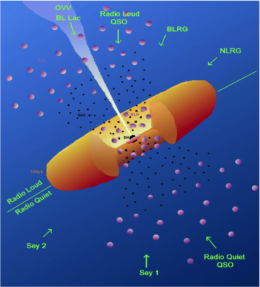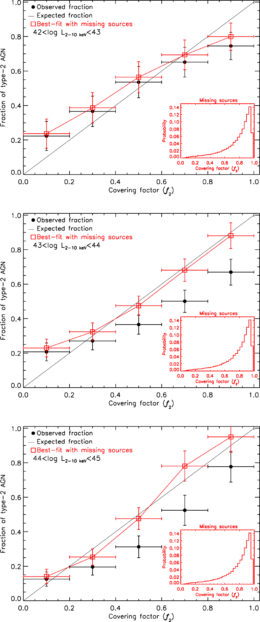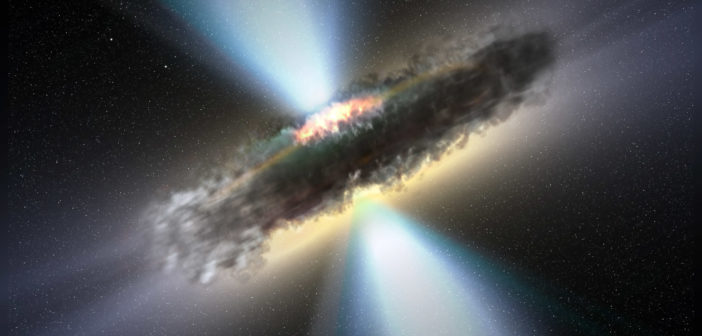Supermassive black holes are thought to grow in heavily obscured environments. A new study now suggests that many of the brightest supermassive black holes around us may be escaping our detection as they hide in these environments.

The geometric dependence of AGN types in the unified AGN model. Type 1 AGN are viewed from an angle where the central engine is visible. In Type 2 AGN, the dusty torus obscures the central engine from view. [Urry & Padovani, 1995]
A Torus Puzzle
The centers of galaxies with bright, actively accreting supermassive black holes are known as active galactic nuclei, or AGN. According to a commonly accepted model for AGN, these rapidly growing black holes and their accretion disks are surrounded by a thick torus of dust. From certain angles, the torus can block our direct view of the central engines, changing how the AGN appears to us. AGN for which we can see the central engine are known as Type 1 AGN, whereas those with an obscured central region are classified as Type 2.
Oddly, the fraction of AGN classified as Type 2 decreases substantially with increasing luminosity; brighter AGN seem to be more likely to be unobscured. Why? One hypothesis is that the torus structure itself changes with changing AGN luminosity. In this model, the torus recedes as AGN become brighter, causing fewer of these AGN to be obscured from our view.
But a team of scientists led by Silvia Mateos (Institute of Physics of Cantabria, Spain) suggests that we may instead be missing the bigger picture. What if the problem is just that many of the brightest obscured AGN are too well hidden?
Geometry Matters

Type 2 AGN fraction vs. torus covering factor for AGN in the authors’ three luminosity bins. The black line shows the 1-to-1 relation describing the expected Type 2 AGN fraction; the black data points show the observed fraction. The red points show the best-fit model including the “missing” AGN, and the inset shows the covering-factor distribution for the missing sources. [Mateos et al. 2017]
The team next used clumpy torus models to estimate the distributions of AGN covering factors, the geometric factor that describes the fraction of the sky around the AGN central engine that’s obscured.
The pointing directions for AGN should be randomly distributed, and geometry then dictates that the covering factor distributions combined over the total AGN population should match the intrinsic fraction of AGN classified as Type 2 AGN. Instead, the sample from BUXS reveals a “missing” population of high-covering-factor tori that we have yet to detect in X-rays.
Missing Sources
When they include the missing AGN, Mateos and collaborators find that the total fraction of Type 2 AGN is around 58%. They also show that more of these AGN are missing at higher luminosities. By including the missing ones, the total fraction of obscured AGN therefore has a much weaker dependence on luminosity than we thought — which suggests that the receding torus model isn’t necessary to explain observations.
Mateos and collaborators’ results support the idea that the majority of very bright, rapidly accreting supermassive black holes at redshifts of z ≤ 1 live in nuclear environments that are extremely obscured. These black holes are so well embedded in their environments that they’ve escaped detection in X-ray surveys thus far.
Citation
S. Mateos et al 2017 ApJL 841 L18. doi:10.3847/2041-8213/aa7268

4 Comments
Pingback: hidden black holes
Pingback: Amerikan Gökbilim Derneği (AAS) Bülteni | Günün NASA Görüntüsü
Pingback: ¿Agujeros negros escondidos, revelados? – Observatori Astronòmic
Pingback: Núcleos activos de galaxias « SEDA / LIADA - RedLIADA - Cursos LIADA - Cielo del Mes - Fenómenos Astronómicos - RELEA